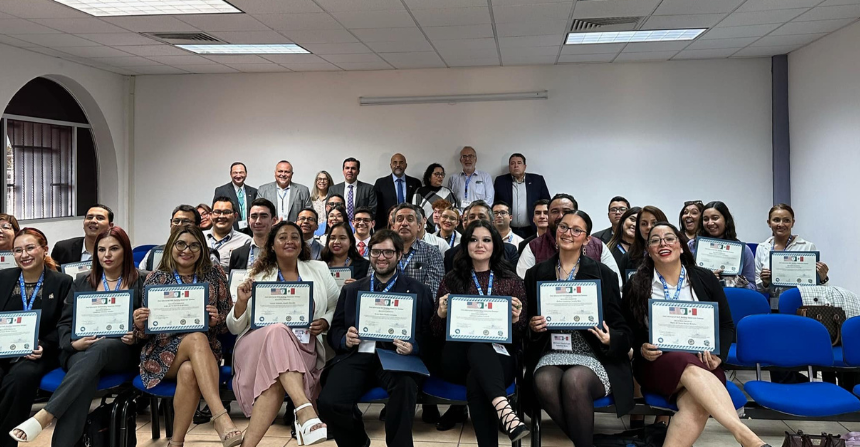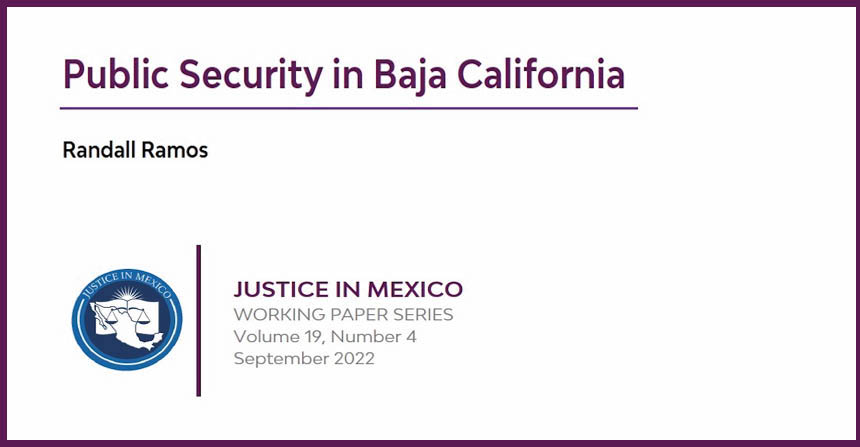 02/07/10—Drawing on new data released by the Mexican government, the Trans-Border Institute issued a report today on drug violence in Mexico. The report, titled Drug Violence in Mexico: Data and Analysis Through 2010, was authored by Viridiana Ríos and David Shirk and builds on a previous study released one year earlier. The new study reviews available data and analyzes the factors that contributed to extreme levels of violence in Mexico through 2010, the worst year on record.
02/07/10—Drawing on new data released by the Mexican government, the Trans-Border Institute issued a report today on drug violence in Mexico. The report, titled Drug Violence in Mexico: Data and Analysis Through 2010, was authored by Viridiana Ríos and David Shirk and builds on a previous study released one year earlier. The new study reviews available data and analyzes the factors that contributed to extreme levels of violence in Mexico through 2010, the worst year on record.
According to Mexican government data, more than 34,550 killings were officially linked to organized crime during the administration of President Felipe Calderón (2006-12). Based on multiple years of monitoring drug violence in Mexico, the 15,000 organized crime killings that occurred in 2010 set a new record as well as an increase of nearly 60% from the previous year.
The new TBI report underscores the geographic concentration of violence, with 84% of all homicides from organized crime in 2010 occurring in just four of Mexico’s 32 states (Chihuahua, Sinaloa, Guerrero and Baja California) and over 70% occurring in 80 of the country’s roughly 2,450 municipalities. The top five most violent municipalities in 2010 were Ciudad Juárez (2,738 killings), Culiacán (587), Tijuana (472), Chihuahua (670), and Acapulco (370), which together accounted for 32% of all the drug-related homicides in 2010.
Despite this concentration, several areas saw sharp increases due to new clashes among drug traffickers. Four states experienced large, sudden spikes in violence during the course of the last year: San Luis Potosí (from 8 homicides per year in 2009 to 135 in 2010), Tamaulipas (90 to 1209), Nayarit (37 to 377), and Nuevo León (112 to 604). Splinter organizations —the Beltran Leyva, La Familia Michoacana, and Zeta drug trafficking organizations—that have broken from the major cartels were contributed to the upsurge in violence in these areas.
The report also notes a qualitative shift in violence over the last year, with an increase in the targeting government officials and civilians. In 2010, there was an unprecedented number of elected officials, police, military, and civilians that were caught in the crossfire, including 14 mayors and 11 journalists. In January 2011, two additional mayors were killed, for a total of more than 30 since 2004.
The report reviews recent successes by the Mexican government in dismantling the leadership structures of major drug trafficking organizations, but warns that these efforts could have unpredictable effects. In 2010, the Mexican government’s counter-drug efforts led to the capture of several high-profile traffickers, including Teodoro “El Teo” García Simental, Edgar “La Barbie” Valdez, and Nazario “El Chayo” Moreno, which authorities believe may help bring a reduction, if not an end to the violence. However, the report notes that the disruption of organized crime groups also has destabilizing effects, including increased violence among traffickers as well as the targeting of government officials and ordinary citizens.
Viridiana Ríos is a doctoral candidate at Harvard University and a research associate of the Trans-Border Institute. David Shirk is the director of the Trans-Border Institute and principal investigator of the Justice in Mexico Project.





Pingback: TRANS-BORDER INSTITUTE RELEASES REPORT ON DRUG VIOLENCE IN MEXICO « Mexico Institute
The rate of drug related violence (deaths per 100,000 population) is greatest in numeious small municipalities in northern Mexico. Actually, the rate in Ciudad Juarez ranks only 10th. The rate in Ciudad Juarez in less than one fourth that of Guadalupe, Chihuahua; Mier, Tamaulipas; or General Trevino, Nuevo Leon.
For information on drug related deaths per 100,000 population for states, key cities, the most violent municipalities and municipalities of particular interest to ex-pats, go to:
http://geo-mexico.com/?p=3428. Or http://geo-mexico.com/?s=drug+deaths.
The Body Count As Seen From Texas
Wednesday, 12 January 2011 23:56
Jeffrey Wright
On Friday, Jan. 7, one day before Gabrielle Gifford was shot in Tuscon, Arizona, another politician turned up riddled with bullets in a state that borders Texas. Saúl Vara Rivera, the mayor of Zaragoza, Coahuila, was discovered in a field outside of Monterrey, his back pumped full of 23 bullets. Of course it came as no surprise that the Coahuila incident failed to trigger media motion sensors in the United States, where the news cycle was utterly consumed with the Arizona madman’s mass murder and political assassination. Sadly, though, Vara Rivera’s slaying barely garnered any national coverage in Mexico, either.
There are undoubtedly multiple reasons for the disparate press responses between the two countries to the shooting of a politician (and let’s remember that Gifford survived), but clearly one prominent factor is that political assassinations have simply become business-as-usual in many parts of Mexico. Vara Rivera was the first mayor of the year to be liquidated, but in 2010 between 13 and 15 mayors had their lives snuffed out by narco cartel gunmen, not to mention the dozens of police commanders and security officials who met similar fates. Moreover, on this occasion Mexico’s national media had more grisly fodder for their coverage: 15 decapitated bodies were dumped in Acapulco in a parking lot on Jan. 8.
On Wednesday, Jan. 12, the federal government unveiled a new national database of homicides related to narcotics violence, the first time it has published a rigorous, full accounting of the cartel carnage. The report was methodically compiled in conjunction with independent citizen groups and prominent academics. The database showed that in the 49 months from Dec. 2006, when President Felipe Calderón assumed office and launched a sweeping security crackdown on drug traffickers, up through December 2010, a whopping 34,612 men, women and children have lost their lives.
Almost one-fifth, or 18.6 percent, of drug-linked homicides occurred in the infamously lethal Ciudad Juárez, a large maquiladora city crowded up to the river banks across from El Paso. More broadly, the large state of Chihuahua, where Juárez is located, claimed the lion’s share of narco homicides during the same period: an astounding 29.3 percent. (Curiously, though, nearly all of the remaining 3,698 Chihuahua victims were located in the interior of the state and not along the New Mexico or Texas border. Juárez is the exception, albeit a massive one.)
The second-deadliest Mexican state with a shared border with Texas was Tamaulipas – also the closest to San Antonio. A distant second it is, though– only 4.3 percent of the national total, trailing far behind Chihuahua’s 29.3 percent. Los Pinos’ new database tallies 1,475 narco-related slaying in Tamaulipas – roughly one per day through the four years and one month it covers. Reynosa, Tamaulipas held the dubious distinction of topping the list with 230 killings, or 5 per month, followed by San Fernando, away from the border and on the coast with 173, and then Nuevo Laredo, our closest neighboring Mexican city, with 159, or about 3 per month.
The state of Nuevo León, which shares a very small segment of border with Texas but claims much more important cultural and economic linkages due to the prominent ties between San Antonio and Monterrey, suffered 971 narco-related slaughters, only 2.8 percent of the grand national total, and only 0.02 percent of the state’s relatively large population. Monterrey was the deadliest city in Nuevo León, registering 297 losses, some 6 per month.
Finally, Coahuila, the fourth state to border Texas, recorded 659 trafficking deaths, a slim 1.9 percent of the 34,612 body count during Calderón’s war on drugs. The vast bulk of these occurred far from the border in the battlefield of Torreón and nearby Matamoros (not to be confused with the Matamoros, Tamaulipas border city).
Pingback: American Heroes » U.S. State Department Issues Mexico Travel Warning
Pingback: CFR REPORT: THE DRUG WAR IN MEXICO « Justice in Mexico
Pingback: CFR REPORT: THE DRUG WAR IN MEXICO « Mexico Institute
Pingback: Mexico Institute Background Resources for President Felipe Calderón’s Vis « Mexico Institute
Pingback: Tijuanapress.com Week In Review « Matt Bowler's San Diego News Updates
Pingback: Politics heats up in this week’s Tijuana Press Review | MexicoReporter.com
Pingback: An in-depth analysis of drug violence in Mexico from the University of San Diego’s Trans-Border Institute | Geo-Mexico, the geography of Mexico
Pingback: An in-depth analysis of drug violence in Mexico from the University of San Diego’s Trans-Border Institute | Geo-Mexico, the geography of Mexico
Pingback: Drug Violence in Mexico Data and Analysis Through 2010 - City-Data Forum
q gacho
estamos jodidos
Pingback: Internal migration flows below the radar in Mexico | Tapachula en Línea
Pingback: Internal migration flows below the radar in Mexico | San Diego Bar Reviews
Pingback: Silver Miners Undeterred by Mexican Drug War | Silver Investing News
Pingback: Silver Miners Undeterred by Mexican Drug War
Pingback: Wanna go to Juarez | mexicuh